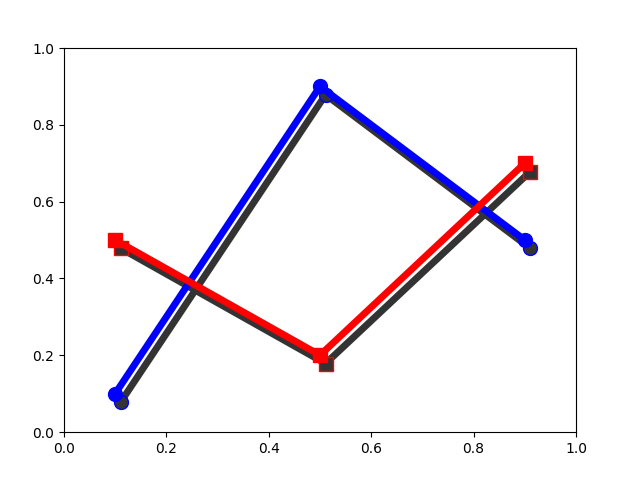Observação
Clique aqui para baixar o código de exemplo completo
Nº da linha do filtro SVG
Demonstrar efeitos de filtragem SVG que podem ser usados com Matplotlib.
Observe que os efeitos de filtragem só são eficazes se o seu renderizador SVG for compatível.

Saving 'svg_filter_line.svg'
import io
import xml.etree.ElementTree as ET
import matplotlib.pyplot as plt
import matplotlib.transforms as mtransforms
fig1 = plt.figure()
ax = fig1.add_axes([0.1, 0.1, 0.8, 0.8])
# draw lines
l1, = ax.plot([0.1, 0.5, 0.9], [0.1, 0.9, 0.5], "bo-",
mec="b", lw=5, ms=10, label="Line 1")
l2, = ax.plot([0.1, 0.5, 0.9], [0.5, 0.2, 0.7], "rs-",
mec="r", lw=5, ms=10, label="Line 2")
for l in [l1, l2]:
# draw shadows with same lines with slight offset and gray colors.
xx = l.get_xdata()
yy = l.get_ydata()
shadow, = ax.plot(xx, yy)
shadow.update_from(l)
# adjust color
shadow.set_color("0.2")
# adjust zorder of the shadow lines so that it is drawn below the
# original lines
shadow.set_zorder(l.get_zorder() - 0.5)
# offset transform
transform = mtransforms.offset_copy(l.get_transform(), fig1,
x=4.0, y=-6.0, units='points')
shadow.set_transform(transform)
# set the id for a later use
shadow.set_gid(l.get_label() + "_shadow")
ax.set_xlim(0., 1.)
ax.set_ylim(0., 1.)
# save the figure as a bytes string in the svg format.
f = io.BytesIO()
plt.savefig(f, format="svg")
# filter definition for a gaussian blur
filter_def = """
<defs xmlns='http://www.w3.org/2000/svg'
xmlns:xlink='http://www.w3.org/1999/xlink'>
<filter id='dropshadow' height='1.2' width='1.2'>
<feGaussianBlur result='blur' stdDeviation='3'/>
</filter>
</defs>
"""
# read in the saved svg
tree, xmlid = ET.XMLID(f.getvalue())
# insert the filter definition in the svg dom tree.
tree.insert(0, ET.XML(filter_def))
for l in [l1, l2]:
# pick up the svg element with given id
shadow = xmlid[l.get_label() + "_shadow"]
# apply shadow filter
shadow.set("filter", 'url(#dropshadow)')
fn = "svg_filter_line.svg"
print(f"Saving '{fn}'")
ET.ElementTree(tree).write(fn)